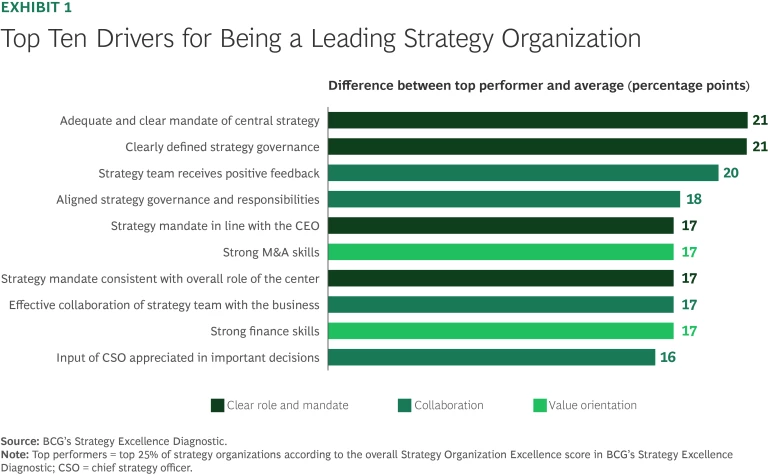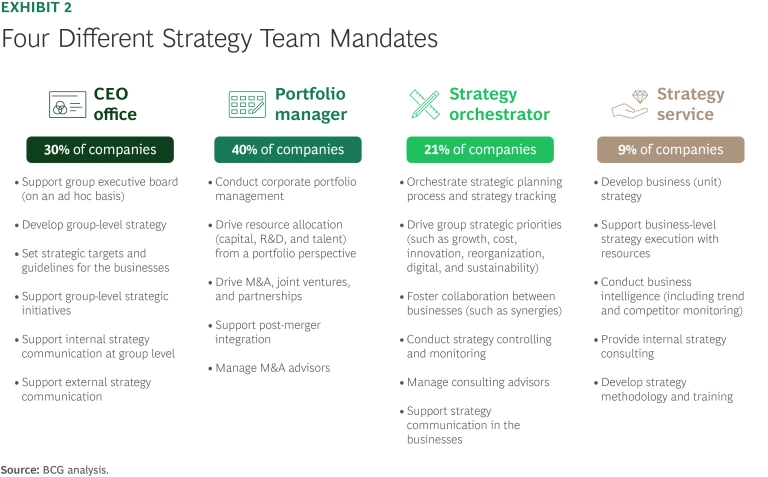CEOs aiming to shape strategy have a powerful ally: their strategy organization. These teams help them think through and facilitate high-stakes decisions and drive concrete strategic initiatives.
Unfortunately, these organizations often come up short. According to BCG’s Strategy Excellence Diagnostic database of more than 430 strategy organizations, upwards of 50% of senior executives report that they are unsatisfied with their company’s strategy teams. (See the sidebar “Decoding Strategy Organizations.”) In fact, 32% of chief strategy officers (CSOs) themselves believe they aren’t succeeding.
Decoding Strategy Organizations
The underlying database was created by surveying executives at more than 430 companies from a broad range of industries and geographies, making it the largest such data set available to date. About 75% of companies are from Europe and North America, and more than 85% have sales above $1 billion.
We define strategy organizations to be top performing if they have a top-quartile overall excellence score. That score is determined as an average of all benchmarking dimensions.
Our goal was to gain data-driven insight on what makes a strategy organization successful. The key success factors are not what some might believe: outperformance doesn’t hinge on the diversity of the team or on its digital, communication, or project management skills. And bigger strategy organizations are not necessarily better.
We analyzed the degree to which top-performing strategy organizations differed from average teams in the 87 dimensions in our database. We found ten dimensions where top performer scores stood out most. (See Exhibit 1.) They excel in three primary ways: they have a clear mandate and governance, have mastered the art of collaboration, and complement strategy with strong value-oriented skills like M&A.

Clarify Mandate and Governance
The data is clear: mandate- and governance-related dimensions are the key differentiator of high-performing strategy teams. We observe four different mandates of strategy teams. (See Exhibit 2.) In 30% of companies, the strategy organization’s primary role is being the “CEO office,” supporting top management in developing group strategy and setting strategic targets. At 40% of companies, the strategy function mainly acts as “portfolio manager,” systematically evaluating the corporate business portfolio and helping to guide and shape it along the way. Another 21% are “strategy orchestrators,” facilitating strategy development and strategic decision making by the leadership team. One out of ten strategy teams focuses on providing “strategy service,” which means they are actively involved in shaping strategy and supporting the business with strategic business intelligence. These mandates are not mutually exclusive; 60% of strategy functions have a secondary mandate as well.

There are top performers in all categories. And no one mandate is clearly superior. Rather, outperformance is driven by choosing the mandate that adds value in a specific situation and aligning it with key stakeholders. We find that strategy teams with more than one mandate actually lower their probability of being a top performer by 15%. Most important, alignment with the CEO is essential. If the CEO and CSO are not aligned, there is a fundamental problem.
Alignment with the CEO is essential. If the CEO and chief strategy officer are not aligned, there is a fundamental problem.
A frequent trigger to rethink the strategy organization’s mandate is a change of CEO or CSO leadership. At one multinational, for example, the new CSO drove a redesign of the company’s strategy approach based on two key observations. First, investments were being driven by the clout and power of business unit leaders rather than a systematic assessment of future opportunities. Second, even when the right opportunities were identified, the company had weak strategy execution within the business.
To address these issues, the CEO and CSO shifted the strategy organization from a service mandate that focused on execution toward a portfolio manager approach. This included developing systematic, clear rules for strategic allocation of capital and leaving execution to the business unit leaders, ensuring better frontline attention and accountability.
Strategy governance is another key factor in performance. It covers dimensions like organizational setup, the steering model, and the interaction model with other parts of the business. At four out of ten of the companies in the database, strategy governance hasn’t been defined. However, nearly all top performers have taken this step. In fact, the biggest difference we observed between underperforming strategy organizations and average performers was whether strategy governance was clearly defined. Defining governance includes a clear reporting line for the CSO. At 64% of the companies, the CSO reports directly to the CEO. At 26% of companies, the reporting line is to the CFO. In three out of four companies, the CSO is part of the executive committee or the executive management board.
It is also helpful to define how the strategy organization will work with the business. At 40% of companies, strategy resources are “pushed” onto the business. At a quarter of firms there is a “pull” model, whereby central strategy teams are only leveraged if the business demands it. At the remaining companies, both models exist. There is no clear right or wrong in making these choices; top performing strategy functions show very similar patterns in this area when compared with average teams. Rather, these things must be clear and explicitly agreed upon between key stakeholders.
Master Collaboration
The strategy team’s ability to collaborate effectively is a major determinant of success. In the end, group and business leaders must own strategy development and execution; the strategy function is their lever and support. Thus, it’s no wonder that receiving positive feedback from the organization is right behind mandate and governance as the most important success factor.
The strategy function has two internal clients: the business it supports and the group board. Yet only 22% of companies we benchmarked were deemed to “collaborate effectively with the business.” For top performers, the share was 56%. At the same time, at all top performers, the “perspective of the head of strategy is appreciated by the board,” while for one-third of average companies that is not the case.
The strategy team’s ability to collaborate effectively is a major determinant of success.
High-performing strategy organizations are mostly centralized but also retain some decentralized resources. This allows them to work effectively with both the group board and business leaders. The typical strategy organization has 58% of its team located centrally, with the rest located within the business. We find that the probability of being a top performer is 20% higher when 60% to 80% of the strategy function sits centrally. Having more than 80% of strategy resources located centrally can also work well, with an average success rate. By contrast, decentralized strategy organizations—especially those with less than 40% of resources located centrally—have only about half the success rate of average companies.
Bring Value-Oriented Skills
Marrying strategy with a value perspective is critical for success. Among the most important performance drivers are finance and M&A skills—even more critical than strategic thinking skills and market and business know-how. More general skills like project and process management, communication and networking, and digital know-how are not distinguishing.
A lack of these general skills, however, are the key reason why underperformers fail. Bottom-quartile performers falter on these fundamentals: they are 22% weaker in strategic thinking, 21% weaker in business know-how, and 19% weaker in communication skills.
Team diversity is frequently claimed to be essential for top-performing teams. In our data set, we find that top performers are barely more diverse than the average in terms of gender, personal background, or culture and just slightly better with respect to diversity in functional expertise or experience at different companies. Top performers seem to struggle with diversity just as much as other companies do.
Is Bigger Better?
A high-performing strategy organization requires adequate resources. In our database, the typical central strategy team has 11 full-time equivalents (FTEs). However, resourcing is highly dependent on company size, with a median of 2.5 FTE per $1 billion in sales.
High-performing strategy organizations often earn the right to enlarge the team because they add value to the company.
But company size is not the sole determinant of a strategy organization’s staffing levels. Our analysis finds that team size is also highly dependent on factors such as the degree of business portfolio diversification and where the company is headquartered. Industry does not have a statistically significant impact on the size of the strategy team. If the organization has an internal consulting business unit, that naturally leads to larger strategy teams.
High-performing strategy teams tend to be roughly 50% larger than the average. In our view and experience, this does not necessarily mean that larger strategy teams perform better. If the key drivers such as mandate and governance are not in place, larger strategy teams are not necessarily effective. Instead, high-performing strategy organizations often earn the right to enlarge the team because they add value to the company. High-performing teams get larger, not the other way around.
The CEO’s Strategy Leverage
As a CEO with ambition to shape strategy, a high-performing strategy organization is your ally. To get started, CEOs and CSOs need to come together to understand the most pressing business needs from a strategic perspective:
- Does the company need a higher-quality strategy?
- Should it push for more innovation and impulses?
- Is there a need for better alignment of resource allocation with strategy?
- Does execution require more discipline?
The answer to these questions will clarify which strategy mandate, or combination of mandates, can best deliver impact from a strategic perspective. Companies should then define governance consistently with the mandate and align these choices with the rest of the organization. These choices also inform what resources are required and which specific skills will make a difference.
Creating a clear mandate, focusing on collaboration, and maintaining a value perspective will make the strategy organization a critical CEO lever for making the most pressing strategy decisions.






